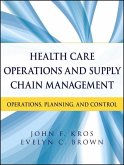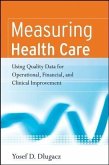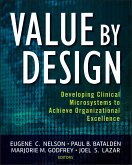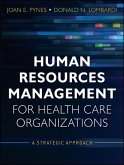Health Care Operations and Supply Chain Management (eBook, PDF)
Operations, Planning, and Control


Alle Infos zum eBook verschenken

Health Care Operations and Supply Chain Management (eBook, PDF)
Operations, Planning, and Control
- Format: PDF
- Merkliste
- Auf die Merkliste
- Bewerten Bewerten
- Teilen
- Produkt teilen
- Produkterinnerung
- Produkterinnerung

Hier können Sie sich einloggen

Bitte loggen Sie sich zunächst in Ihr Kundenkonto ein oder registrieren Sie sich bei bücher.de, um das eBook-Abo tolino select nutzen zu können.
Health Care Operations and Supply Chain Management This innovative text offers a thorough foundation in operations management, supply chain management,?and the strategic implementation of programs, techniques, and tools for reducing costs and improving quality in health care organizations. The authors incorporate the features and functions of Microsoft Excel where appropriate in their coverage of supply chain strategy, process design and analysis of health care operations, managing health care operations quality, and planning and controlling health care operations. Health Care Operations and…mehr
- Geräte: PC
- mit Kopierschutz
- eBook Hilfe
- Größe: 24.73MB
![Health Care Operations and Supply Chain Management (eBook, ePUB) Health Care Operations and Supply Chain Management (eBook, ePUB)]() John F. KrosHealth Care Operations and Supply Chain Management (eBook, ePUB)84,99 €
John F. KrosHealth Care Operations and Supply Chain Management (eBook, ePUB)84,99 €![Value Based Health Care (eBook, PDF) Value Based Health Care (eBook, PDF)]() Yosef D. DlugaczValue Based Health Care (eBook, PDF)68,99 €
Yosef D. DlugaczValue Based Health Care (eBook, PDF)68,99 €![Measuring Health Care (eBook, PDF) Measuring Health Care (eBook, PDF)]() Yosef D. DlugaczMeasuring Health Care (eBook, PDF)65,99 €
Yosef D. DlugaczMeasuring Health Care (eBook, PDF)65,99 €![Value by Design (eBook, PDF) Value by Design (eBook, PDF)]() Eugene C. NelsonValue by Design (eBook, PDF)75,99 €
Eugene C. NelsonValue by Design (eBook, PDF)75,99 €![Quality By Design (eBook, PDF) Quality By Design (eBook, PDF)]() Quality By Design (eBook, PDF)75,99 €
Quality By Design (eBook, PDF)75,99 €![Essentials of Health Care Organization Finance (eBook, PDF) Essentials of Health Care Organization Finance (eBook, PDF)]() Dennis D. PointerEssentials of Health Care Organization Finance (eBook, PDF)60,99 €
Dennis D. PointerEssentials of Health Care Organization Finance (eBook, PDF)60,99 €![Human Resources Management for Health Care Organizations (eBook, PDF) Human Resources Management for Health Care Organizations (eBook, PDF)]() Joan E. PynesHuman Resources Management for Health Care Organizations (eBook, PDF)72,99 €
Joan E. PynesHuman Resources Management for Health Care Organizations (eBook, PDF)72,99 €-
-
-
Dieser Download kann aus rechtlichen Gründen nur mit Rechnungsadresse in A, B, BG, CY, CZ, D, DK, EW, E, FIN, F, GR, HR, H, IRL, I, LT, L, LR, M, NL, PL, P, R, S, SLO, SK ausgeliefert werden.
- Produktdetails
- Verlag: John Wiley & Sons
- Seitenzahl: 576
- Erscheinungstermin: 12. Dezember 2012
- Englisch
- ISBN-13: 9781118418840
- Artikelnr.: 37345563
- Verlag: John Wiley & Sons
- Seitenzahl: 576
- Erscheinungstermin: 12. Dezember 2012
- Englisch
- ISBN-13: 9781118418840
- Artikelnr.: 37345563
- Herstellerkennzeichnung Die Herstellerinformationen sind derzeit nicht verfügbar.
Preface xxi
The Authors xxxi
PART I STRATEGY 1
Chapter 1 Health Care Operations and Supply Chain Strategy 3
Health Care Operations and Supply Chain Management 4
Purchasing, Logistics, and Vendor-Managed Inventories 7
Efficiency, Effectiveness, and Value 8
Competitive Dimensions of Health Care 12
The Bullwhip Effect in Health Care 14
MiniCase: The Bullwhip Effect in Health Care Organizations 18
Chapter 2 Financial Aspects of Health Care Operations and Supply Chain
Management 21
Health Care Finance and Operations/Supply Chain Management 22
Income Statement/Operating Statement 24
Balance Sheet 27
Statement of Cash Flows 32
Basic Financial Ratios and Metrics 35
Time Value of Money 47
Break-Even Analysis 49
Crossover Analysis 53
Chapter 3 Managerial Accounting Aspects of Health Care Operations and
Supply Chain Management 61
Managerial Aspects of Health Care Operations and Supply Chain Management 62
Managerial Accounting 62
Activity-Based Costing 65
Supply Chain Management behind the Scenes: Cost Drivers at Hospitals 69
PART II PROCESS DESIGN AND ANALYSIS OF HEALTH CARE OPERATIONS 75
Chapter 4 Data and Statistical Tools for Health Care Operations Improvement
77
Descriptive Statistics for Describing Data Sets 78
Graphical Methods of Data Description 78
Numerical Methods of Data Description 81
Hypothesis Testing: Analyzing the Difference of Two Means 101
Pareto Analysis 116
Box-and-Whisker Plots 117
Tornado Diagrams and Sensitivity Analysis 129
Chapter 5 Problem Solving and Decision-Making Tools in Health Care
Operations 143
Health Care Operations and Supply Chain Management in Action: How Legal
Decision Makers Use Decision Models 144
Framing the Decision Problem 146
Components of a Decision-Making Problem 146
Payoff Tables 149
Decision-Making Criteria without Probability Assessments 151
Decision-Making Criteria with Probability Assessments 159
Expected Value of Perfect Information 162
Modeling 177
Decision Trees 179
Chapter 6 Simulation 201
Introduction 202
Process Flows 202
Probability Distributions 203
Random Number Generation 210
Discrete-Event versus Continuous Simulation 211
Monte Carlo Simulation 213
Agent-Based Simulation 215
Simulation in Health Care 215
Queuing Analysis 216
Chapter 7 Process Improvement and Patient Flow 229
Introduction 230
Process Mapping 231
Value Stream Mapping 233
Use of Maps and Charts in Health Care 240
Staffing 242
Workload Management 243
Productivity and Efficiency Analysis 245
Common Health Care Productivity and Efficiency Measures 248
Improving Productivity and Efficiency 249
MiniCase: Improving Process Flow to Improve Service-Level Performance
Statistics 253
Chapter 8 Facility Layout 257
Introduction 257
Layout Considerations 258
Types of Layouts 262
Muther Diagrams 264
Workload Management 266
Evaluating Different Types of Layouts 267
Basics of Optimization 270
Optimization Using Excel Solver 272
Optimizing Facility Layout and Design 280
PART III MANAGING HEALTH CARE OPERATIONS QUALITY 287
Chapter 9 Managing Quality in a Health Care Setting 289
What Is Service Quality? 290
Quality Planning, Control, and Improvement 291
Quality and Financial Performance 292
Seven Tools for Quality Control 294
Six Sigma Concepts 305
Six Sigma and Lean 311
MiniCase: Delayed Room Cleaning Dilemma 320
Chapter 10 Quality Control and Improvement 323
Design of Quality Control Systems 324
Process Quality Control 324
Variables Control 327
Using Control Charts 331
Process Capability 334
Total Quality Management and Continuous Improvement 337
International Organization for Standardization Certification 338
Malcolm Baldrige Award 340
PART IV PLANNING AND CONTROLLING HEALTH CARE OPERATIONS 351
Chapter 11 Lean Concepts in Health Care 353
Introduction 354
What Is Lean? 354
Controlling Waste 355
Controlling Flow with a Kanban System 357
Kaizen Events 359
Value Stream Mapping 362
Measures and Tools 362
Adverse Effects of Becoming Too Lean 364
MiniCase: Using Lean Concepts to Improve Inpatient Care 366
Chapter 12 Forecasting for Health Care Management 369
Analyzing Data Using Time Series and Regression Models 370
Linear and Nonlinear Trends 371
Seasonality in Data 372
Naive Forecasting 376
Moving Averages 378
Weighted Moving Averages 381
Exponential Smoothing 383
Autocorrelation 387
Regression as a Forecasting Technique 393
Multiple Regression Model 402
Measuring Accuracy 409
Measuring Forecasting Errors 423
Chapter 13 Project Management 431
Introduction 432
Role of Project Manager 432
Objectives and Trade-Offs 433
Planning and Control in Projects 435
Project Scheduling 437
Critical Path Method 440
Gantt Charts 448
Program Evaluation and Review Technique 451
Implementation 453
MiniCase: Implementing Electronic Medical Records at St. Hampton's Hospital
457
Chapter 14 Aggregate Planning, Scheduling, and Capacity Management in
Health Care 461
Aggregate/Central Planning 462
Resource Planning and Control 464
Scheduling and Capacity Management 468
Workforce Scheduling 468
Dispatching Rules 473
Job Sequencing 474
Johnson's Rule 475
Service Facility Location Analysis 486
Center of Gravity Method 487
Chapter 15 Inventory Management 501
Introduction 502
Purpose of Inventories 502
Costs of Inventories 504
Economic Order Quantity 506
Independent versus Dependent Demand 509
Periodic Review Systems 510
Continuous Review Systems 511
ABC Inventory Management 515
Inventory Management Technology 519
Index 525
Preface xxi
The Authors xxxi
PART I STRATEGY 1
Chapter 1 Health Care Operations and Supply Chain Strategy 3
Health Care Operations and Supply Chain Management 4
Purchasing, Logistics, and Vendor-Managed Inventories 7
Efficiency, Effectiveness, and Value 8
Competitive Dimensions of Health Care 12
The Bullwhip Effect in Health Care 14
MiniCase: The Bullwhip Effect in Health Care Organizations 18
Chapter 2 Financial Aspects of Health Care Operations and Supply Chain
Management 21
Health Care Finance and Operations/Supply Chain Management 22
Income Statement/Operating Statement 24
Balance Sheet 27
Statement of Cash Flows 32
Basic Financial Ratios and Metrics 35
Time Value of Money 47
Break-Even Analysis 49
Crossover Analysis 53
Chapter 3 Managerial Accounting Aspects of Health Care Operations and
Supply Chain Management 61
Managerial Aspects of Health Care Operations and Supply Chain Management 62
Managerial Accounting 62
Activity-Based Costing 65
Supply Chain Management behind the Scenes: Cost Drivers at Hospitals 69
PART II PROCESS DESIGN AND ANALYSIS OF HEALTH CARE OPERATIONS 75
Chapter 4 Data and Statistical Tools for Health Care Operations Improvement
77
Descriptive Statistics for Describing Data Sets 78
Graphical Methods of Data Description 78
Numerical Methods of Data Description 81
Hypothesis Testing: Analyzing the Difference of Two Means 101
Pareto Analysis 116
Box-and-Whisker Plots 117
Tornado Diagrams and Sensitivity Analysis 129
Chapter 5 Problem Solving and Decision-Making Tools in Health Care
Operations 143
Health Care Operations and Supply Chain Management in Action: How Legal
Decision Makers Use Decision Models 144
Framing the Decision Problem 146
Components of a Decision-Making Problem 146
Payoff Tables 149
Decision-Making Criteria without Probability Assessments 151
Decision-Making Criteria with Probability Assessments 159
Expected Value of Perfect Information 162
Modeling 177
Decision Trees 179
Chapter 6 Simulation 201
Introduction 202
Process Flows 202
Probability Distributions 203
Random Number Generation 210
Discrete-Event versus Continuous Simulation 211
Monte Carlo Simulation 213
Agent-Based Simulation 215
Simulation in Health Care 215
Queuing Analysis 216
Chapter 7 Process Improvement and Patient Flow 229
Introduction 230
Process Mapping 231
Value Stream Mapping 233
Use of Maps and Charts in Health Care 240
Staffing 242
Workload Management 243
Productivity and Efficiency Analysis 245
Common Health Care Productivity and Efficiency Measures 248
Improving Productivity and Efficiency 249
MiniCase: Improving Process Flow to Improve Service-Level Performance
Statistics 253
Chapter 8 Facility Layout 257
Introduction 257
Layout Considerations 258
Types of Layouts 262
Muther Diagrams 264
Workload Management 266
Evaluating Different Types of Layouts 267
Basics of Optimization 270
Optimization Using Excel Solver 272
Optimizing Facility Layout and Design 280
PART III MANAGING HEALTH CARE OPERATIONS QUALITY 287
Chapter 9 Managing Quality in a Health Care Setting 289
What Is Service Quality? 290
Quality Planning, Control, and Improvement 291
Quality and Financial Performance 292
Seven Tools for Quality Control 294
Six Sigma Concepts 305
Six Sigma and Lean 311
MiniCase: Delayed Room Cleaning Dilemma 320
Chapter 10 Quality Control and Improvement 323
Design of Quality Control Systems 324
Process Quality Control 324
Variables Control 327
Using Control Charts 331
Process Capability 334
Total Quality Management and Continuous Improvement 337
International Organization for Standardization Certification 338
Malcolm Baldrige Award 340
PART IV PLANNING AND CONTROLLING HEALTH CARE OPERATIONS 351
Chapter 11 Lean Concepts in Health Care 353
Introduction 354
What Is Lean? 354
Controlling Waste 355
Controlling Flow with a Kanban System 357
Kaizen Events 359
Value Stream Mapping 362
Measures and Tools 362
Adverse Effects of Becoming Too Lean 364
MiniCase: Using Lean Concepts to Improve Inpatient Care 366
Chapter 12 Forecasting for Health Care Management 369
Analyzing Data Using Time Series and Regression Models 370
Linear and Nonlinear Trends 371
Seasonality in Data 372
Naive Forecasting 376
Moving Averages 378
Weighted Moving Averages 381
Exponential Smoothing 383
Autocorrelation 387
Regression as a Forecasting Technique 393
Multiple Regression Model 402
Measuring Accuracy 409
Measuring Forecasting Errors 423
Chapter 13 Project Management 431
Introduction 432
Role of Project Manager 432
Objectives and Trade-Offs 433
Planning and Control in Projects 435
Project Scheduling 437
Critical Path Method 440
Gantt Charts 448
Program Evaluation and Review Technique 451
Implementation 453
MiniCase: Implementing Electronic Medical Records at St. Hampton's Hospital
457
Chapter 14 Aggregate Planning, Scheduling, and Capacity Management in
Health Care 461
Aggregate/Central Planning 462
Resource Planning and Control 464
Scheduling and Capacity Management 468
Workforce Scheduling 468
Dispatching Rules 473
Job Sequencing 474
Johnson's Rule 475
Service Facility Location Analysis 486
Center of Gravity Method 487
Chapter 15 Inventory Management 501
Introduction 502
Purpose of Inventories 502
Costs of Inventories 504
Economic Order Quantity 506
Independent versus Dependent Demand 509
Periodic Review Systems 510
Continuous Review Systems 511
ABC Inventory Management 515
Inventory Management Technology 519
Index 525







